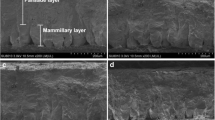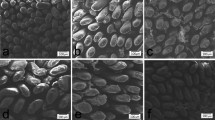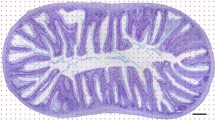Abstract
Four trials were conducted to determine if toxic levels of mercury affect kidney development, morphology, and renal function. Mercury, administeredvia the drinking water as mercuric chloride caused a reduction in gross kidney weight, an increase in relative kidney weight and a slight but significant increase in the percentage water retained by left kidney of 6-week-old cockerels. Mercury had no effect on renal function of 6-week-old birds as indicated by the clearance of phenol red from circulation. Histological discontinuity of the kidney was extensive and evidenced by foamy cell degeneration and nuclear pyknosis. Although mercury caused gross alterations in the morphology of the kidney, normal excretory function was maintained.
Similar content being viewed by others
References
Dawson, A. B., H. M. Evans, and G. H. Whipple: Behavior of large series of dyes introduced into the circulating blood. Am. J. Physiol.51, 232 (1920).
Fowler, B. A.: Ultrastructural evidence for nephropathy induced by long-term exposure to small amounts of methyl mercury. Science175, 780 (1972).
Friberg, L.: Studies on the accumulation, metabolism and excretion of inorganic mercury Hg-203 after prolonged subcutaneous administration to rats. Acta Pharmacol.12, 411 (1956).
Ganote, C. E., K. A. Reimer, and R. B. Jennings: Acute mercuric chloride nephrotoxicity: An electron microscopic and metabolic study. Lab. Invest.31, 633 (1974).
Klein, R., S. P. Herman, B. C. Bullock, and F. A. Talley: Methyl mercury intoxifications in rat kidneys: Functional and pathological changes. Arch. Pathol.96, 83 (1973).
Kramer, C. Y.: Extension of multiple range tests to group means with unequal numbers of replications. Biometrics,12, 307 (1956).
Mudge, G. H.: Diuretics and other agents employed in the mobilization of edema fluids. In L. S. Goodman and A. Gilman (eds.): The Pharmacological Basis of Therapeutics. 4th ed., pp. 827–858. Toronto: MacMillan (1970).
Parkhurst, C. R., and P. Thaxton: Toxicity of mercury to young chickens. 1. Effect on growth and mortality. Poultry Sci.52, 273 (1973).
Pitts, R. F.: The excretion of phenol red by the chicken. J. Cell. Comp. Physiol.11, 99 (1938).
Price, R. G., and S. A. Kempson: The effect of mercuric chloride on rat kidney cortical plasma membranes. Biochem. Soc. Trans.3, 294 (1975).
Rodin, A. E., and C. N. Crowson: Mercury nephrotoxicity in the rat. 1. Factors influencing the localization of the tubular lesions. Amer. J. Pathol.41, 297 (1962).
Rothstein, A., and A. D. Hayes: Metabolism of mercury in the rat studied by isotope techniques. J. Pharmacol. Exp. Ther.130, 166 (1960).
Siller, W. G.: Structure of the kidney. In D. J. Bell and B. M. Freeman (eds.): Physiology and Biochemistry of the Domestic Fowl. Vol. 1, pp. 197–231. London-New York: Academic Press (1971).
Steel, R. G. D., and J. H. Torrie: Principles and Procedures of Statistics. New York-Toronto-London: McGraw-Hill (1960).
Sykes, A. H.: Formation and composition of urine. In D. J. Bell and B. M. Freeman (eds.): Physiology and Biochemistry of the Domestic Fowl. Vol. 1, pp. 233–278. London-New York: Academic Press (1971).
Thaxton, P., C. R. Parkhurst, L. A. Cogburn, and P. S. Young: Adrenal function in chickens experiencing mercury toxicity. Poultry Sci.54, 578 (1975).
Thaxton, P., P. S. Young, L. A. Cogburn and C. R. Parkhurst: Hematology of mercury toxicity in young chickens. Bull. Environ. Contamin. Toxicol.12, 46 (1974).
Trojanowska, B.: The distribution and excretion of mercury203Hg in rats after daily injections of phenyl-mercury acetate. Proc. XV Int. Congr. Occup. Health, Vienna, A. III-26, 261 (1966).
Ware, R. A., P. M. Burkholder, and L. W. Chang: Ultrastructural changes in renal proximal tubules after chronic organic and inorganic mercury intoxication. Environ. Res.10, 121 (1975).
Author information
Authors and Affiliations
Additional information
Paper Number 5300 of the Journal Series of the North Carolina Agricultural Experiment Station, Raleigh, North Carolina 27607.
A preliminary report of part of this paper was presented to the 73rd annual meeting of the Southern Association of Agricultural Scientists, Atlanta, Ga.
Rights and permissions
About this article
Cite this article
Hester, P.Y., Brake, J., Sikes, C.V. et al. The excretory system of young chickens experiencing mercury toxicity—effects on kidney development, morphology, and function. Arch. Environ. Contam. Toxicol. 7, 257–271 (1978). https://doi.org/10.1007/BF02332054
Received:
Accepted:
Issue Date:
DOI: https://doi.org/10.1007/BF02332054




